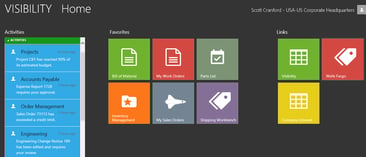Cloud vs. On Premise ERP
By: Scott Cranford
To deploy a cloud based ERP solution or a more traditional on premise ERP solution? Why not do both? Well, at least have the alternative to choose one or the other, right?
Let’s take a look at some of the factors in deciding on how to decide on cloud or on premise ERP.
Cost of Ownership
A cloud deployment of an ERP solution offers a fixed monthly fee for the use of the software, access, ongoing customer support, product updates and maintenance, security, backup and Disaster Recovery (DR). These services range greatly in terms of monthly investment however; they eliminate the up-front licensing fees associated with an on premise ERP deployment. In this model, the software is “rented” and delivered “as a service” (SaaS).
As such, your monthly and annual costs are known and can be precisely budgeted for. That offers a great deal of budgeting flexibility for companies’ annual IT expenditures. Contrast that with an on premise deployment where there is the more traditional “ownership” model along with an annual support and maintenance fee. On premise is certainly a high investment up front but over a longer term, can certainly be more economical.
IT Infrastructure and Resources
An in place data center and trained staff to support it, lends itself to an on premise deployment of an ERP solution. This allows companies to be quite self-sufficient from a systems perspective. But there is a cost to that sufficiency and some companies may simply prefer to allow their ERP vendor to take care of the care and feeding of the solution.
With a SaaS or Cloud ERP deployment, companies can rely on the vendor to provide support and can count on those vendors to deliver high availability and take responsibility for the technology to deliver their applications.
Core Competency
A positive for the cloud deployment model is that it allows manufacturing companies to maintain focus on their core competencies. Whether they produce industrial equipment, aircraft components, machinery or electronics, companies can remain focused on the design, sales and delivery of their products and services offerings. This allows them to eliminate any distraction with regards to their underlying business system.
Security and Compliance
Some companies are faced with regulatory requirements and compliance regulations that can certainly influence the decision. ITAR and DCAA requirements shape defense contracting manufacturing companies’ deployment strategies. Broader than that though, companies need to assess their tolerance for company specific, proprietary data residing amongst the ether. In models, data security and access is critical. Ultimately, who has responsibility in addressing those is a big part of the cloud / on premise ERP decision.

Conclusion
Visibility offers both on premise and cloud ERP deployment models and can help your business evaluate the options in this important decision. And, Visibility has years of successful manufacturing ERP experience with companies who have chosen one model and then migrated to the other. Perhaps there are budgetary constraints that indicate that a cloud deployment makes sense initially?
Then, after a period of time Visibility can migrate the environment to an on premise data center. Alternatively, start on premise and if goals and objectives shift, allow Visibility to migrate to a new cloud instance with no effort on behalf of the company.
To learn more about Visibility, get in touch with us. You can contact us online or give us a call at 978-269-6500.


